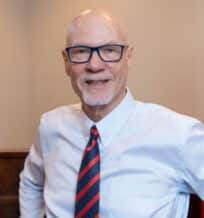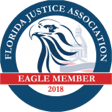Brooks Law Group Scholarship Second Place Winner by Kavya Shah
Vincent Pascucci
The evening of August 29th, 2017 was like any other in Florida: picturesque, complete with a cool summer breeze and an awe-inspiring sunset. Vincent Pascucci, a 27-year-old Winter Haven native known by his friends as Vinny, was soaking in the beauty of the day on his Suzuki Sport motorcycle when his life abruptly ended.
At around 8:20 PM, Pascucci approached a Ford Focus on the inside lane of Cypress Gardens Boulevard. Riding well over the speed limit, Pascucci neared closer and closer to the back of the car. He locked the brakes on his bike, causing him to slide 147 feet on the road before striking the back of the Ford Focus. Upon impact, Pascucci was flung 150 feet from his motorcycle, which skidded for another 200 feet (1).
Vincent Pascucci died upon impact. He was young, hard-working, and had a promising future. His friends especially miss his “beautifully cocky smile,” one that “you knew was going to take the world by storm” (2). A loyal employee of a local pizzeria in Winter Haven, Pascucci still had a lot to contribute to this world. He didn’t deserve to die. He, however, was not wearing a helmet.
Pascucci’s story, while tragic, is not uncommon. In the United States, over 93,000 motorcyclists were injured or killed in a motor accident in 2015 alone (3). Moreover, these accidents are much more dangerous than accidents of other motor vehicles. In 2015, the fatality rate by vehicle miles traveled was 22.1 times higher for motorcyclists than automobile drivers (3, 4). Upon first glance, motorcycles seem to be just like any other mode of transportation. Why is it, then, that motorcycle crashes are so fatally serious?
Motorcyclists and Helmets
The most oft-cited piece of advice to motorcyclists—and rightfully so—is to always wear a helmet. This isn’t without reason, as helmets are around 37% effective in preventing motorcycle crash-related deaths (5). Thus, it is logical for states to pass legislation, known as universal helmet laws, requiring all motorcyclists to wear helmets. Alas, only 19 states, of which Florida is not one, have such policies. This may seem ludicrous, but there is justification for a lack of universal helmet laws. First, many states have an alternative safeguard in place of requiring helmets. Florida, for instance, requires all motorcyclists over the age of 21 not wearing helmets to carry $10,000 in medical insurance, ensuring that they will be able to pay for their hospital expenses in the event of a crash. But the second reason for a lack of universal helmet laws, and perhaps the more important one, stems from the culture of the motorcyclist community. One of the principal allures of riding a motorcycle—in all age groups—is the feeling of the rush of wind against one’s face, a feeling that is mitigated when wearing a helmet. Furthermore, riding a motorcycle has been described as a liberating experience. As Floridian motorcycle enthusiast Phil Nicosi of Indian Harbour Beach states, “It’s a part of freedom.
Feeling free and unencumbered” (6). There are also practical concerns. Helmets can trap heat, causing motorcyclists in already temperate regions like Florida to sweat profusely.
Thus, due to the discomfort caused by helmets, many motorcyclists decide to forgo wearing them. This decision is significant, as helmets saved an estimated 1,859 lives in 2016 (7). To solve this cultural issue, the motorcyclist community must foster an attitude that encourages helmet use. Rather than emphasizing the reckless nature of bikes, motorcyclists would be much safer discussing the joy to be derived even with a helmet. Motorcyclists can ride during evenings to “beat the heat” and still enjoy the blast of wind against their body. If the motorcyclist community compromises and shifts toward a culture more conducive to helmet use, countless lives, like that of Vincent Pascucci’s, can be saved.
Motorcycles vs. Cars
Another important aspect of the fatal danger in motorcycle crashes stems from the obvious structural differences between motorcycles and automobiles. Automobiles inherently offer much more stability and safety to drivers for a myriad of reasons. First and foremost, automobiles contain seat belts, which have been unequivocally proven to save the lives of those in motor accidents. In fact, the National Highway Traffic Safety Administration estimates that seat belts annually save a whopping 15,000 passenger lives (8), proving their worth. Additionally, automobiles provide the symmetrical support of four wheels, making balancing the vehicle a trivial task. And finally, most automobiles are encased in a metal frame, partially shielding the driver and passengers from the outside environment. Motorcycles, on the other hand, lack seat belts, have only two wheels, and expose riders to their surroundings, making them highly unsafe by default.
This structural instability in motorcycles makes motorcyclists highly susceptible to injuries that automobile drivers do not have to worry about, further exemplifying why motorcycle crashes are so serious. One such well-known injury that motorcyclists must beware of is road rash, which involves the individual’s body painfully—and sometimes fatally— scraping against the asphalt. Also, they must avoid getting too close to other vehicles or objects and risk a compression injury, in which the motorcyclist gets wedged between the bike and the object. The worst compression injuries can cause intense bruising or break one’s rib cage, instantly killing them.
Tips for Motorcycle Safety
To protect themselves from road rash and compression injuries and help offset the structural danger of motorcycles, bikers can take several simple steps. As the Brooks Law Group advises, motorcyclists should always don the proper attire, including “heavy denim, protective gear, footwear that covers your ankles, and gloves” (9). Though it may seem cumbersome, this gear will pay huge dividends in the event of a crash, as the clothing shields the skin from scraping against the road or heavy objects. As an added measure, motorcyclists can wear highly visible and bright clothing to remain conspicuous to drivers of large vehicles. In fact, a case study completed by the Iowa State University in 2012 finds that bright clothing is “highly effective” in making motorcyclists easily visible (10), and thus less likely to get hit by automobile drivers unknowingly. Another equally important step that motorcyclists must take is to drive at the posted speed limit. In 2016, one-third of all motorcycle drivers involved in crashes were found to be speeding (11). Speeding decreases the balance of the rider and the bike, making it very easy to spin, veer out of control, and crash. These solutions, while easy to state, will be hard to implement. However, by encouraging bikers to take a broad perspective on the value of their lives and the merits of safe motorcycling, we can begin to encourage habits that will lessen the frequency and severity of motorcycle crashes.
When discussing danger on a national scale, it is easy to dismiss the thousands of annual motorcyclist deaths as mere statistics. This dismissal, however, would be a grave mistake on our part, as it is the responsibility of all U.S. citizens—motorcyclists or not—to contribute towards adequate road safety. In summary, the simplest reason for why motorcycle crashes are so serious is the lack of helmets worn by bikers. This issue arises from a deeply entrenched paradigm in the motorcyclist community, but with the concerted efforts of all its members, the wearing of helmets can be strongly encouraged. Another primary danger in motorcycle crashes is the high level of instability in bikes, leading to potential road rash and compression injuries. To solve this problem, motorcyclists are advised to wear heavy and bright protective clothing, making them shielded and visible. If we can adopt these solutions in the mainstream, we will be one step closer to making sure that what happened to Vincent Pascucci will not happen to anyone else, ever again.
About Me
My name is Kavya Shah, and I am a 17-year-old senior at Windermere High School, in Windermere, FL. Next year, I plan on going to a 4-year university to study molecular biology. I am extremely passionate about my environment and would like to one day become a plant pathology researcher. Along with environmental science, I am also very involved in my local community, volunteering as a tutor at my high school, front desk greeter at my local hospital, and computer science teacher at my old middle school.
I know that paying for college will pose a significant burden on my parents, who have already been very supportive of me for the past 17 years. So, I am entering the Brooks Law Group Scholarship Contest to help alleviate some of this strain. Thank you for choosing such an interesting essay topic to write on!
References
- Staff, L. (2017, September 01). PCSO deputies seek witnesses to fatal accident in Winter Haven. Retrieved from https://www.theledger.com/story/news/crime/2017/09/01/pcso-deputies-seek-witnesses-to-fatal-accident-in-winter-haven/18940942007/
- Erickson, T. (2017, August 30). GoFundMe: Funeral Expenses for Vinny. Retrieved from https://www.gofundme.com/f/g6s8xv-funeral-expenses-for-vinny
- Traffic Safety Facts 2015 (2017, March). Retrieved from https://crashstats.nhtsa.dot.gov/Api/Public/ViewPublication/812580
- 2016 Fatal Motor Vehicle Crashes: Overview. (2017, October). Retrieved from https://crashstats.nhtsa.dot.gov/Api/Public/Publication/812456
- Motorcycles and (2016). Retrieved November 2, 2018, from https://www.iihs.org/research-areas/fatality-statistics/detail/motorcycles-and-atvs
- Bonanno, C. (2016, May 14). Florida motorcycle helmet law: Hurt or help in a crash? Retrieved November 2, 2018, from https://www.floridatoday.com/story/news/local/2016/05/10/helmets–no–two–wheeleddebate–continues/80837370/
- Motor Vehicle Safety. (2017, May 31). Retrieved November 2, 2018, from https://www.cdc.gov/motorvehiclesafety/mc/index.html
- News, Y. (2012, February 20). Seatbelts – Saving thousands of lives around the world everyday. Retrieved from http://www.youthforroadsafety.org/news–blog/news-blogitem/t/seatbelts_saving_thousands_of_lives_around_the_world_everyday
- Motorcycle Accidents Taking Lives. (2018, March 02). Retrieved November 2, 2018, from https://brookslawgroup.com/motorcycle–accidents/motorcycle–accidentstaking–lives/
- Marshall, D. (2012, June). Motorcycle Conspicuity – What Factors Have the Greatest Impact. Retrieved November 2, 2018, from http://www.intrans.iastate.edu/research/documents/researchreports/motorcycle_conspicuity_ii_w_cvr.pdf
- Traffic Safety Facts 2016 (2018, March). Retrieved from https://crashstats.nhtsa.dot.gov/Api/Public/ViewPublication/812480














